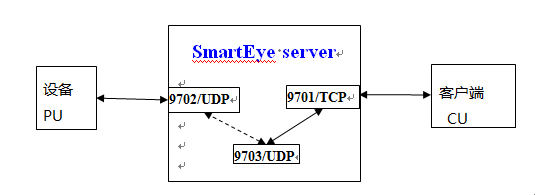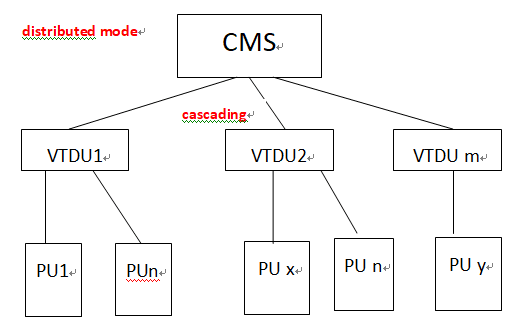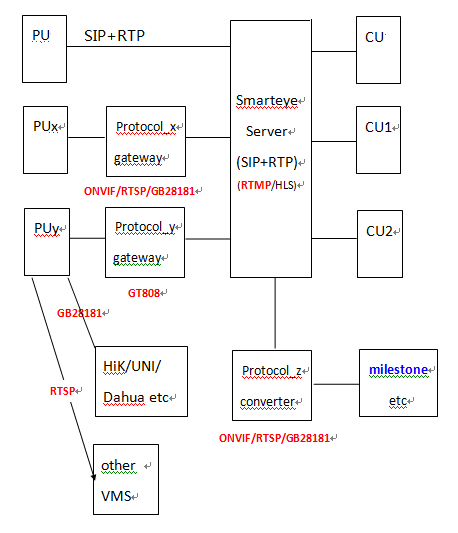Platform docking FAQ on mobile video management platform
1. Platform docking is a common industry demand in mobile video-remote supervision-emergency command and dispatch system.
According to different application scenarios and different industry customer needs, there are various solutions. The mainstream can be roughly divided into the following categories:
(1) The device directly accesses the specified customer platform;
(2) The client platform client (B/S or C/S) is customized based on our client's CUSDK, that is, the client's client accesses the smarteye server to obtain data such as video and audio streams and positioning of the device;
(3) server software to do protocol conversion, direct access to the customer platform, that is, platform and platform docking;
The following is a detailed introduction.
2. Large-scale network video command and dispatch integrated business management platform SmartEye
Network architecture:

Support for distributed cascading and P2P:

Protocol flow:
The protocol used by the UTV 4G transmission device (smarteye protocol) is a streaming media protocol designed for real-time transmission of narrowband wireless channel video and audio streaming media. The main frame is SIP+RTP based on UDP encapsulation, and a dedicated payload for privatization.

Common terms:
1. PU: device, CU: client (including PC client and mobile client MCU);
2. CMS: Central Management Server. Deploy one with database storage PU\CU\VTDU\NRU and other information;
3. NRU: Storage server. It is recommended to deploy only one with the CMS (multiple);
4. VTDU: Streaming media forwarding server. Deploy multiple hosts;
3. The device directly accesses the third-party platform (28181/RTSP)
The UTV 4G image transmission device uses the private smarteye protocol by default, so it can only access the IDEE SmartEye platform by default.
In addition, the excellent 4G image transmission equipment also provides support for the national standard 28181 agreement, so that it can completely bypass the smarteye platform and directly access various national standard platforms, including Haikang, Yushi, Dahua, Netpower, Huawei. Clairvoyance, Infinova, Kodak, etc.
In addition, some of the excellent 4G graphics transmission devices can directly output RTSP streams, which can directly access some specific platforms.
The protocol directly supported by the device will only consider the mainstream, general-purpose protocols (including 28181/RTSP/ONVIF, etc.), and will not consider other non-mainstream niche protocols. For the docking of non-mainstream niche protocols, all clients will be adopted. SDK custom development or platform protocol conversion, and will not be implemented on the device side.
In addition, note that the 28181 protocol itself is not suitable for real-time image transmission of wireless narrowband channels, because 28181 originates from the unified normative access management of the country's social surveillance road camera for safe city, which is completely designed for wired networks, not for wireless. The packet loss processing mechanism of the channel, so when encountering network fluctuations and packet loss, it will inevitably be stuck, flower screen, and the like.
4.Customers use our CUSDK to customize their own industry client software.
Typical industry needs are:
The customer has an existing business management system, such as the water flood control command system, the power operation management dispatch system, the traffic police/urban management business management platform, usually the B/S framework.
The final requirement is to increase the live real-time image, voice, positioning trajectory, high-pixel live photos and voice-scheduled multi-party calls for mobile video through the customer's existing WEB management platform. These functions are all from our 4G graphics transmission equipment.
Customers can quickly integrate integration by calling our WEB SDK (OCX or RTMP/HLS, etc.), and display a new generation of business management system integrating the Vision 4G mobile video subsystem in about 1-2 days.
note:
This kind of solution needs to keep the smarteye server. This software is freely deployed to the customer and can be deployed on the same server PC as the existing own industry platform server software. The working mechanism is:
The customer's WEB client software connects to the smarteye server through our WEB SDK to obtain the video and audio and positioning trajectory of the UTV 4G image transmission device.
Connected with the B/S industry platform, through the WEB SDK provided by us to connect the smarteye server to retrieve the video, audio, video files and positioning tracks of the device, smarteye WEB SDK secondary development instructions and test HOWTO see our technical support Forum posts, there are code level questions can be posted in the forum, we will reply within 10 minutes:
Http://bbs.besovideo.com:8067/forum.php?mod=viewthread&tid=179&extra=page%3D1
5.server to do protocol conversion to other platforms
In some specific industry applications, the device-to-platform protocol cannot be changed (because the private protocol map is the best), and still enters the smarteye platform, and then through the server to do a protocol conversion plug-in, the smarteye proprietary protocol is converted to the customer-specified Protocols, such as 28181, RTSP, ONVIF.
Platform docking FAQ on mobile video management platform
The platform needs 28181, for example, in cooperation with Yushi, from the video private network (operator private network) through the gatekeeper/boundary into the public security network, such a software system architecture is needed.
The platform out of RTSP, for example, many European customers are accustomed to the milestone platform, and it is required to use the milestone client software to view our 4G image transmission device video, which requires such a conversion docking mechanism;
If the platform is out of ONVIF, you can also enter milestone, or connect the NVR to the platform to do centralized storage recording.
6. Smarteye client directly retrieves IPC/NVR video such as Haikang
The SmartEye client makes a custom development client dynamic plug-in. By calling CHKK such as Haikang, it can obtain the video and audio data of IPC/NVR through LAN or cloud (fluorite cloud, xmeye, etc.) to realize mobile video and fixed point monitoring. Seamless integration.

